The Intel Haswell-E CPU Review: Core i7-5960X, i7-5930K and i7-5820K Tested
by Ian Cutress on August 29, 2014 12:00 PM ESTGaming Benchmarks
One of the important things to test in our gaming benchmarks this time around is the effect of the Core i7-5820K having 28 PCIe 3.0 lanes rather than the normal 40. This means that the CPU is limited to x16/x8 operation in SLI, rather than x16/x16.
F1 2013
First up is F1 2013 by Codemasters. I am a big Formula 1 fan in my spare time, and nothing makes me happier than carving up the field in a Caterham, waving to the Red Bulls as I drive by (because I play on easy and take shortcuts). F1 2013 uses the EGO Engine, and like other Codemasters games ends up being very playable on old hardware quite easily. In order to beef up the benchmark a bit, we devised the following scenario for the benchmark mode: one lap of Spa-Francorchamps in the heavy wet, the benchmark follows Jenson Button in the McLaren who starts on the grid in 22nd place, with the field made up of 11 Williams cars, 5 Marussia and 5 Caterham in that order. This puts emphasis on the CPU to handle the AI in the wet, and allows for a good amount of overtaking during the automated benchmark. We test at 1920x1080 on Ultra graphical settings.
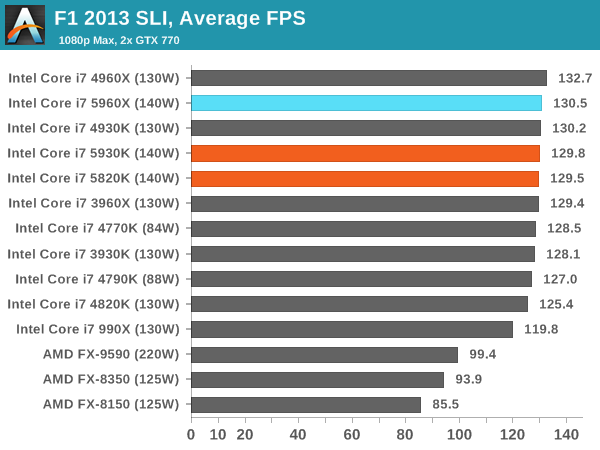
Nothing here really shows any advantage of Haswell-E over Ivy Bridge-E, although the 10% gaps to the 990X for minimum frame rates offer some perspective.
Bioshock Infinite
Bioshock Infinite was Zero Punctuation’s Game of the Year for 2013, uses the Unreal Engine 3, and is designed to scale with both cores and graphical prowess. We test the benchmark using the Adrenaline benchmark tool and the Xtreme (1920x1080, Maximum) performance setting, noting down the average frame rates and the minimum frame rates.
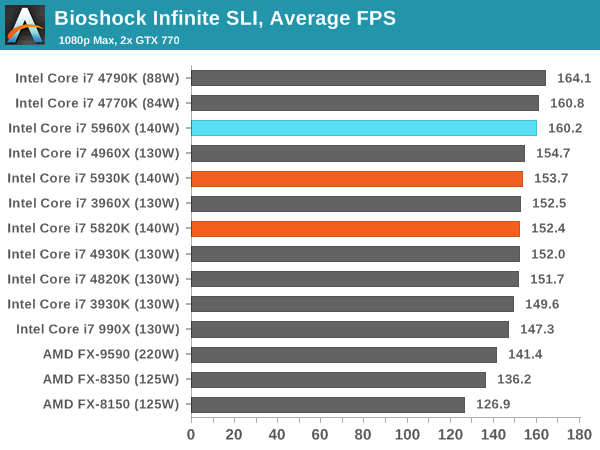
Bioshock Infinite likes a mixture of cores and frequency, especially when it comes to SLI.
Tomb Raider
The next benchmark in our test is Tomb Raider. Tomb Raider is an AMD optimized game, lauded for its use of TressFX creating dynamic hair to increase the immersion in game. Tomb Raider uses a modified version of the Crystal Engine, and enjoys raw horsepower. We test the benchmark using the Adrenaline benchmark tool and the Xtreme (1920x1080, Maximum) performance setting, noting down the average frame rates and the minimum frame rates.
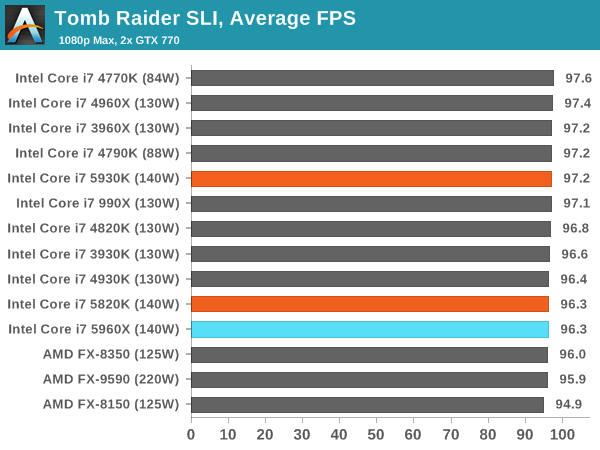
Tomb Raider is blissfully CPU agnostic it would seem.
Sleeping Dogs
Sleeping Dogs is a benchmarking wet dream – a highly complex benchmark that can bring the toughest setup and high resolutions down into single figures. Having an extreme SSAO setting can do that, but at the right settings Sleeping Dogs is highly playable and enjoyable. We run the basic benchmark program laid out in the Adrenaline benchmark tool, and the Xtreme (1920x1080, Maximum) performance setting, noting down the average frame rates and the minimum frame rates.
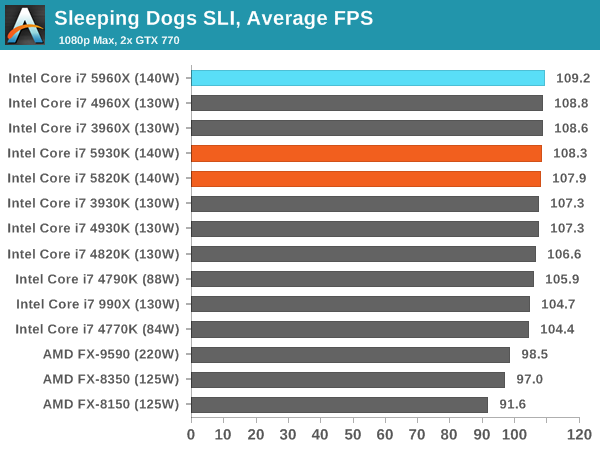
The biggest graph of CPU performance change is the minimum frame rate while in SLI - the 5960X reaches 67.4 FPS minimum, with only the xx60X CPUs of each generation moving above 60 FPS. That being said, all the Intel CPUs in our test are above 55 FPS, though it would seem that the 60X processors have some more room.
Battlefield 4
The EA/DICE series that has taken countless hours of my life away is back for another iteration, using the Frostbite 3 engine. AMD is also piling its resources into BF4 with the new Mantle API for developers, designed to cut the time required for the CPU to dispatch commands to the graphical sub-system. For our test we use the in-game benchmarking tools and record the frame time for the first ~70 seconds of the Tashgar single player mission, which is an on-rails generation of and rendering of objects and textures. We test at 1920x1080 at Ultra settings.
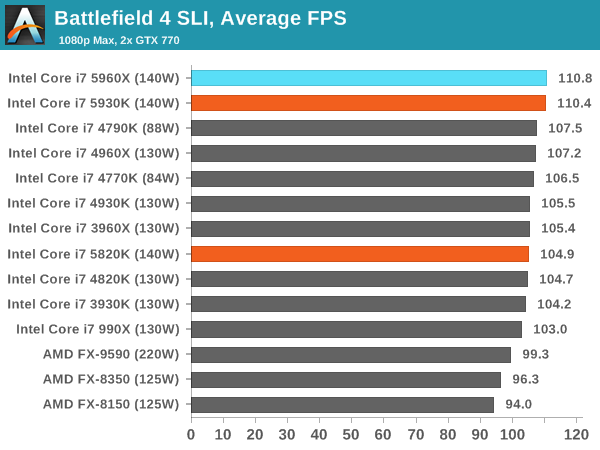
Battlefield 4 is the only benchmark where we see the 5820K with its 28 PCIe lanes down by any reasonable margin against the other two 5xxx processors, and even then this is around 5% when in SLI. Not many users will notice the difference between 105 FPS and 110 FPS, and minimum frame rates are still 75 FPS+ on all Intel processors.















203 Comments
View All Comments
tuxfool - Saturday, August 30, 2014 - link
I'm not so sure it would be of great benefit. Emulators are thread limited by the hardware they're attempting to emulate. I read somewhere that pcsx has a thread limit due to the difficulty in synchronizing each ps2 hardware component in each thread.Dolphin also favors clock speed over simultaneous threads.
bleh0 - Saturday, August 30, 2014 - link
After holding off for 4 years I think it is time for an upgrade. While the builds in the article are good I'm still looking for more.chizow - Saturday, August 30, 2014 - link
Glad I upgraded to Z87+4770K last year. While it is great that Intel *FINALLY* upgraded the rest of their platform to native USB 3.0 and all SATA3 (6G) ports, along with newer options like M.2 and SATA Express, the drop in clocks to accommodate the higher number of cores and higher resultant TDP makes it a wash for my primary purpose: gaming.I also didn't want to have to pay early adopters tax on DDR4, and it looks like that tax is high right now. Coming from X58, I was also very pleased with the drop in total system power going to Z87. I'd estimate between a 920@4GHz and the difference in board power, its pulling about 50W less at idle and 100W less under load. My Kill-A-Watt measurements indicate similar.
Still, if buying today and putting together a new platform for the future, this would be a good option now that Intel has addressed all of the major issues I had with the X79 platform (full native USB 3.0, full native SATA6G, official PCIe 3.0 etc).
@Ian, I am sure it is due to being limited to what you have on hand, but it would have been nice to see some more powerful GPUs tested, just to better illustrate potential CPU performance differences once the GPU bottleneck is lifted. Nice job though, the new graph toggles are really slick.
AsakuraZero - Saturday, August 30, 2014 - link
i was worried about this new processors since i just bought an i7 4770k, and damn im still a happy owner of an amazing chipTEAMSWITCHER - Saturday, August 30, 2014 - link
I pulled the trigger on the 4770K last year also....but I did so only because the Ivy Bridge E was stuck on the X79 chipset. For me, it was an interim solution while I waited for Haswell-E. When my new X99 parts arrive next week, I'll upgrade my system and put the Haswell parts on craigslist - I should be able to sell them for a bargain price and reclaim some cash.AsakuraZero - Sunday, August 31, 2014 - link
the 4770k still sells well on ebay i got mine at 270 (used) looked like new and works likea champ, Haswell e doesnt look bad but in a world where the x86 doesnt use all the cores on many of its applications, or gaming im happy with my purchase, enjoy your CPU and milk every buck out of it!Jonathan_Rung - Saturday, August 30, 2014 - link
"With Haswell LGA1150 CPUs, while the turbo frequency of the i7-4770K was 3.9 GHz, some CPUs barely managed 4.2 GHz for a 24/7 system."I think I spotted a little typo on page 3, did you mean "With Haswell z87..."? I didn't think any of the 4770x CPUs could use an 1150 socket. Or am I misreading it?
Mr Perfect - Saturday, August 30, 2014 - link
The Haswell i7-4770k is socket 1150.http://www.newegg.com/Product/Product.aspx?Item=N8...
Jonathan_Rung - Saturday, August 30, 2014 - link
Oh, you're right. I guess I'm confusing sockets and chipsets. Obviously CPUs need a matching socket, but do they also need a matching chipset, or do newer motherboards just allow newer feature sets introduced by the cpu? Or am I still getting it wrong?It seems like every time a new generation of CPUs are released, a bunch of new motherboards with identical chipsets show up to compliment them, so I thought each generation of CPUs have matching chipset that need to pair with one another.
Sorry, this is like amateur hour, I'll just google this stuff. It's strange, I like reading these articles, but I haven't the slightest idea why - I only understand what they're saying like half of the time!
mcbowler - Saturday, August 30, 2014 - link
at least my dolphin rating is still on top! not sure why that is important.